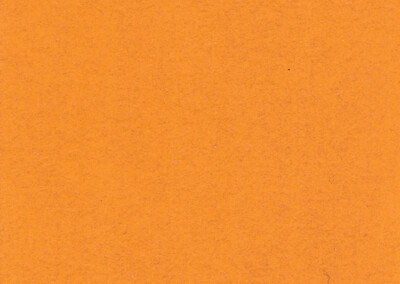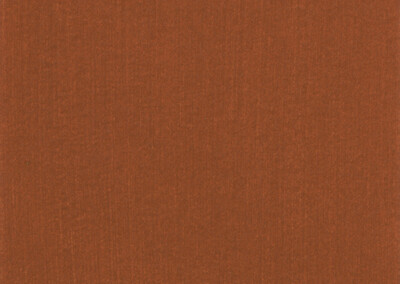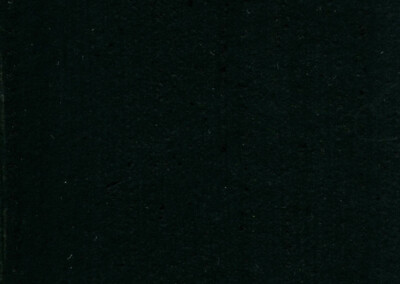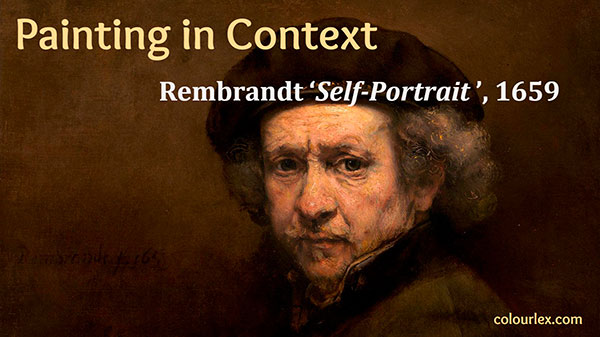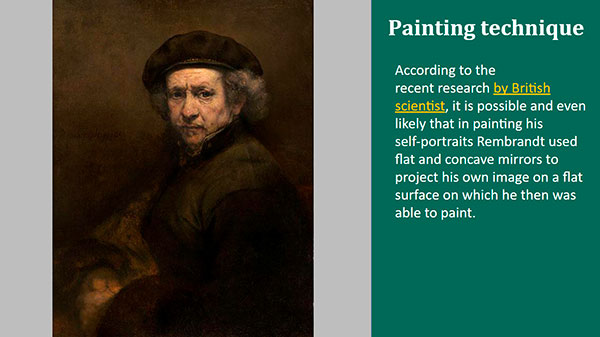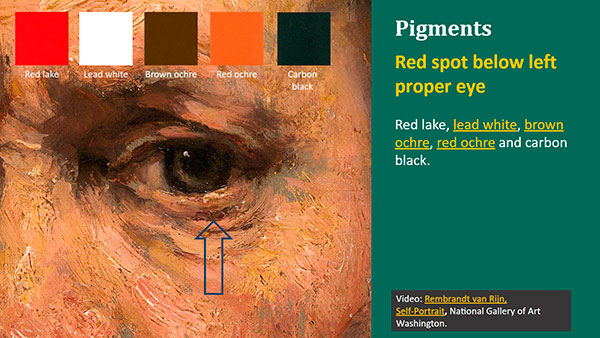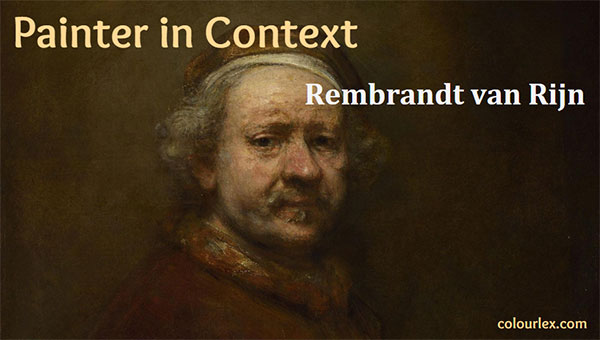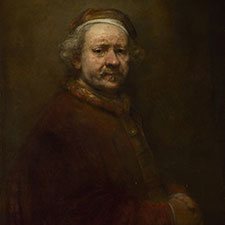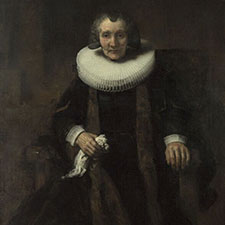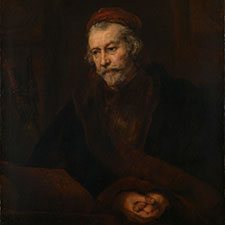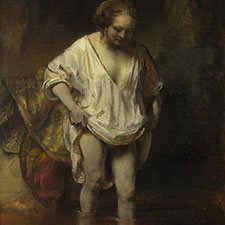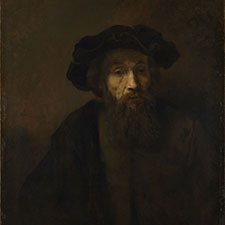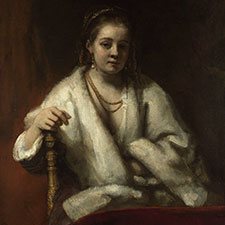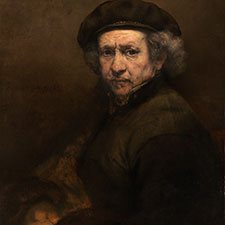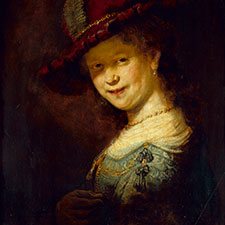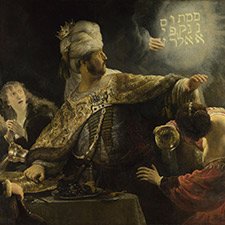Rembrandt, Self-Portrait
1659Rembrandt, Self-Portrait
1659Paintings sorted by Historical period | Painter | Subject matter | Pigments used
Overview
Date: 1659
Medium: Oil
Support: Canvas
Size: 84.5 x 66 cm
Art period: Baroque
National Gallery of Art Washington
Gallery Nr 1937.1.72
A high-resolution image at Google Art Project
Painting in The Rembrandt Database
The layout and pose of this self-portrait were inspired by Raphael’s portrait of Baldassare Castiglione.
 Raphael, Portrait of Baldassare Castiglione, ca 1514-15. Musée du Louvre
Raphael, Portrait of Baldassare Castiglione, ca 1514-15. Musée du Louvre
A. K. Wheelock gives the following description of this painting on the website of the National Gallery of Art in Washington (1):
“Rembrandt painted, drew, and etched so many self-portraits in his lifetime that changes in his appearance invite us to gauge his moods by comparing one image to another. Such a biographical reading is encouraged by the way in which the artist confronts the viewer directly. Rembrandt painted this self-portrait in 1659, after he had suffered financial failure despite so many years of success.”
“The light that so effectively illuminates the head also accents Rembrandt’s left shoulder and, to a lesser extent, his broadly executed clasped hands. Rembrandt’s pose was inspired by Raphael’s famous portrait of Balthasar Castiglione, which had appeared in an auction in Amsterdam in 1639. Following Raphael’s prototype, Rembrandt used the pose, costume, and expression to present himself as a learned painter.”
(1) Arthur K. Wheelock Jr., “Rembrandt van Rijn/Self-Portrait/1659”, Dutch Paintings of the Seventeenth Century, NGA Online Editions.
Painting Technique
According to the recent research by a British scientist (1), it is possible and even likely that in painting his self-portraits Rembrandt used flat and concave mirrors to project his own image on a flat surface on which he then was able to paint.

Diagram of set up for life-size self-portrait projections. Image (c) by the authors of (1)
Quote of the image description for the above image from (1):
In this arrangement, the artist stands at 2× focal length of the concave mirror, which is equal to the sum of the distances between the concave mirror and flat mirror, and the flat mirror and projection surface. A clear, life-size projection was achieved using a 10 cm diameter mirror with focal length 100 cm. A concave mirror with a larger diameter would achieve a larger and more detailed projection. Mirrors of this size or greater are likely to have been available to Rembrandt. In all the described self-portrait systems, a lens placed over a circular flat mirror of the same diameter as that lens, may be used as an alternative to the use of a concave mirror.
References
(1) Francis O’Neill and Sofia Palazzo Corner, Rembrandt’s self-portraits, Journal of Optics, Vol 18, Nr 8 (2016), p. 080401. doi:10.1088/2040-8978/18/8/080401. Available online and as pdf.
Pigments
Pigment Analysis
This pigment analysis is based on the work of scientists Melanie Gifford and Lisha Deming Glinsman at the National Gallery in Washington (1). The restricted palette consists of lead white, bone black, and carbon black and yellow, red, and brown ochres with minute traces of vermilion.
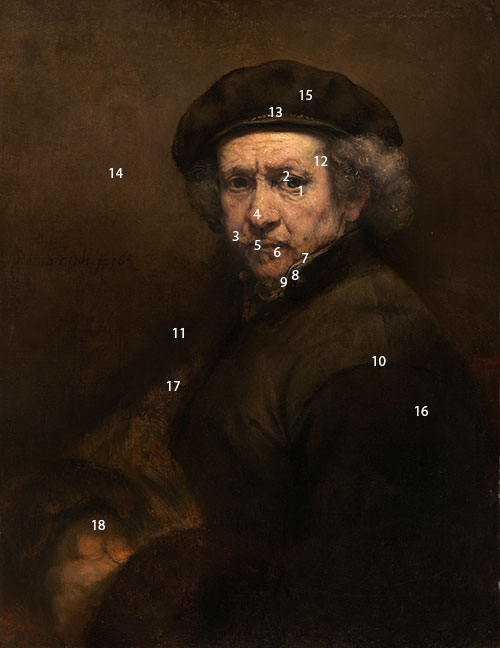
1 The red spot below left proper eye: red lake, lead white, brown ochre, red ochre, and carbon black.
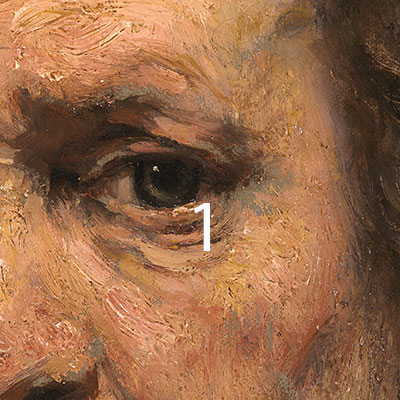
2 White from the left proper eye: lead white with carbon black, red ochre, yellow ochre, and brown ochre.
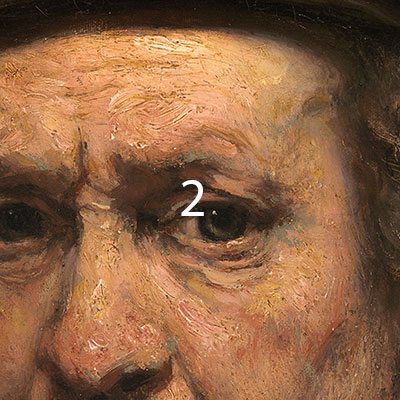
3 Flesh tone in the shadows of the face: lead white, red ochre, brown ochre, and bone black.
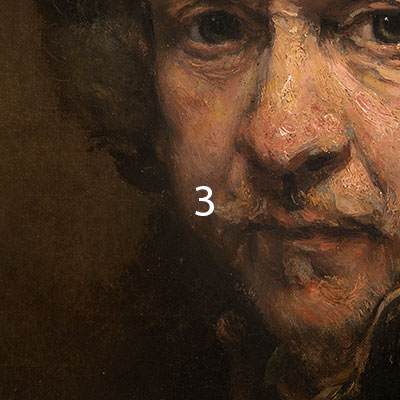
4 Reddish flesh tone on the nose: red ochre, lead white, red lake, and carbon black
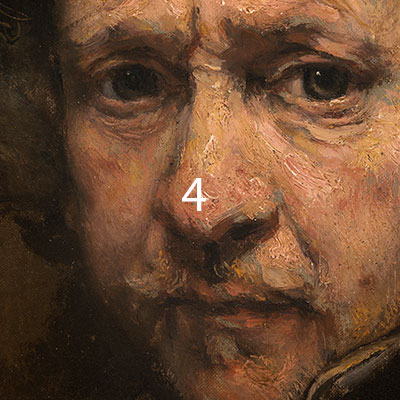
5 Dark shadow on the mouth: red lake over a mixture of red ochre, and carbon black.

6 The pink part of the mouth: red ochre with lead white, yellow and, brown(?) ochre.
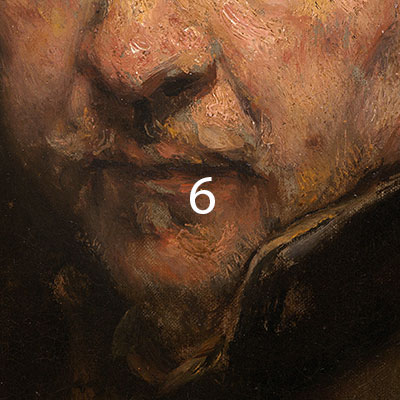
7 Yellow highlight on the collar: yellow ochre over lead white, another layer of yellow ochre, and carbon black.
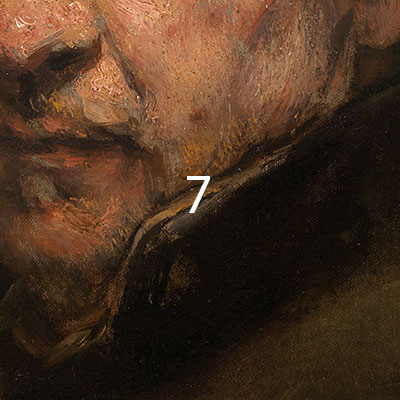
8 Black edge of collar: bone black with brown ochre over lead white, umber, and red lake.
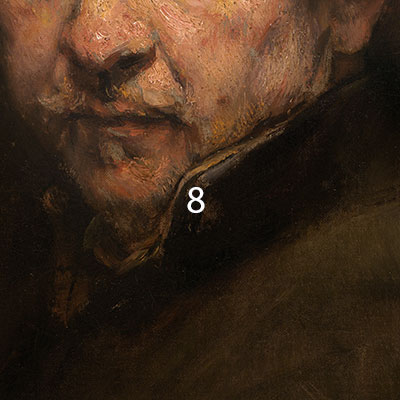
9 Brown edge of collar: Brown ochre and carbon black with a trace of vermilion.
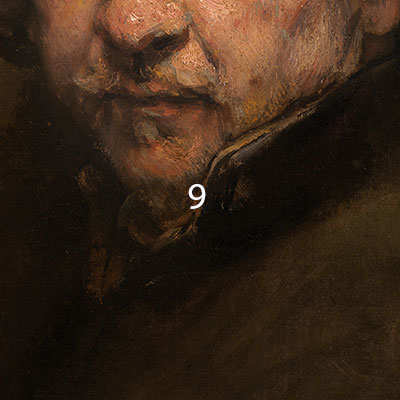
10 Light black coat on the shoulder: bone black, and white lead, yellow ochre.

11 Dark background left of the figure: bone black with yellow ochre, and possibly lead white.

12 Flesh paint at the temple: lead white, red ochre, brown ochre, and carbon black.
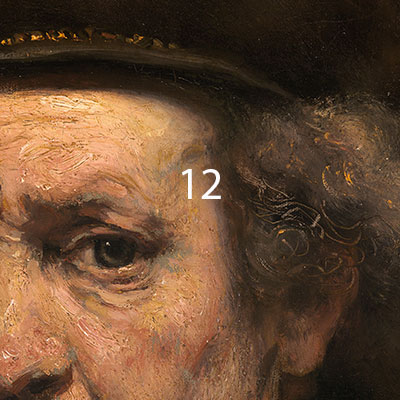
13 Yellow in the hatband: yellow ochre.
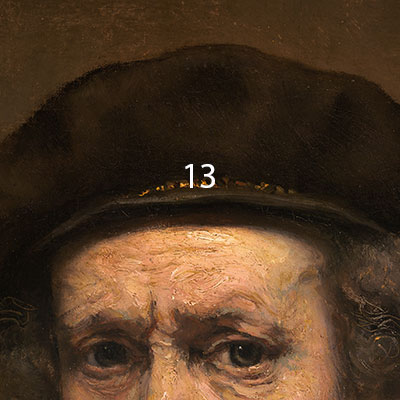
14 Light-colored background to the left of figure: lead white, bone black, and yellow ochre.

15 Black mid-tone of the hat: bone black with traces of lead white and red ochre.
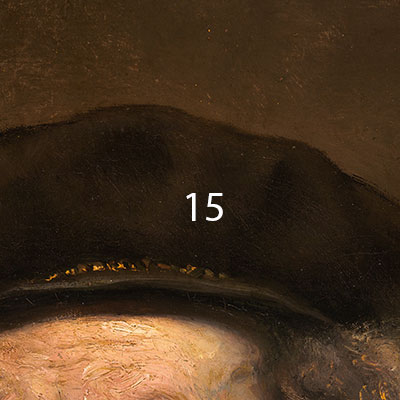
16 The darkest black area of the coat: bone black with traces of white lead, brown ochre, and red ochre.
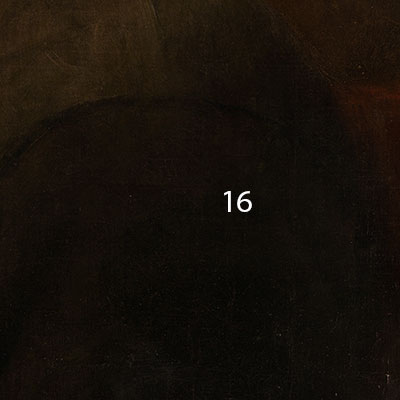
17 Gray-black fur: bone black with traces of lead white, ochres and a trace of vermilion.
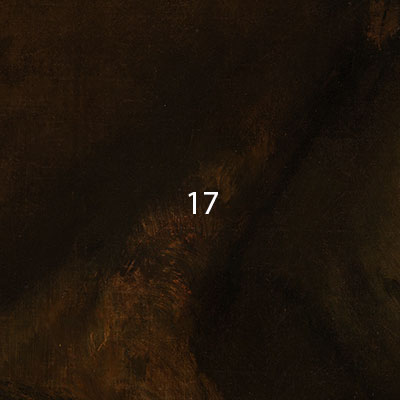
18 The black shadow in the area of the hands: bone black with white lead and red ochre.

References
(1) Gifford M, Glinsman L. Rembrandt van Rijn, Self-Portrait, 1659: Interim Analysis Report. Washington, D.C.: National Gallery of Art; 2014
(2) The Rembrandt Database, various research methods: examination report, 31 July 2014, (record number 16060); Rembrandt Self-portrait, dated 1659, National Gallery of Art (Washington), Washington (D.C.), inv./cat. no. 1937.1.72
Pigments Used in This Painting
Resources
See the collection of online and offline resources such as books, articles, videos, and websites on Rembrandt in the section ‘Resources on Painters‘
PowerPoint Presentations
Painting in Context: Rembrandt Self-portrait, 1659
A richly illustrated presentation on the painting technique and pigments employed by Rembrandt van Rijn specially crafted for Art Education. (Number of Slides = 23)
- Each presentation starts with the basic resources on the painter such as his biography, main catalogs of his paintings, and a bibliography.
- Next, you find slides describing the painting technique of the artist and the pigments he usually employed in his work.
- The majority of the slides show examples of paintings containing the specific pigments.
Slides showing the basic online and written resources on the painting.
According to the recent research by a British scientist, it is possible and even likely that in painting his self-portraits Rembrandt used flat and concave mirrors to project his own image on a flat surface on which he then was able to paint.
The painting is held in muted colors achieved by the use of ochres, lead white, and carbon black. The majority of the slides show the pigment analysis of the entire painting
Painter in Context: Rembrandt
A richly illustrated presentation on the painting technique and pigments employed by Hieronymus Bosch specially crafted for Art Education. (Number of Slides = 20)
- Each presentation starts with the basic resources on the painter such as his biography, main catalogs of his paintings, and a bibliography.
- Next, you find slides describing the painting technique of the artist and the pigments he usually employed in his work.
- The majority of the slides show examples of paintings containing the specific pigments.


The majority of the slides show important examples of paintings where Rembrandt employed specific pigments. The slides are organized according to the color of the pigments.
Videos
Video: 'Rembrandt: The Power of His Self-portraits' by National Gallery London
Video: 'Rembrandt's Self Portraits' by Ashmolean Museum
Video: 'Rembrandt by Himself' by Documentary movies
Video: 'Rembrandt's Self-portraits' by Smarthistory
Video: 'Rembrandt Presents Himself' by Yale University Art Gallery
Publications and Websites
Publications
A Corpus of Rembrandt Paintings, Volumes I – VI, by the scientists of The Rembrandt Research Project are available on the website of The Rembrandt Database in pdf-Format.
(1) E. Van De Wetering, A Corpus of Rembrandt Paintings: The Self-Portraits, Stichting Foundation Rembrandt Research Project, Volume 4, Springer 2005, pp. 498-507.
(2) Tal Friedman, Doron J. Lurie and Avshalom Shalom, Authentication of Rembrandt’s Self-Portraits through the
Use of Facial Aging Analysis, The Israel Medical Association Journal, Vol 14 October 2012, pp 591-94
(3) Rembrandt van Rijn, Self-Portrait, 1659, the website of the National Gallery of Art Washington
(4) Fritz Erpel, Die Selbstbildnisse Rembrandts, p. 46, 184, fig. 56 1967 Wien
Websites
The Rembrandt Database, Object information, Rembrandt, Self-portrait, dated 1659, National Gallery of Art (Washington), Washington (D.C.), inv. no. 1937.1.72


